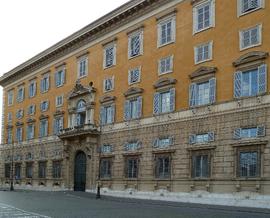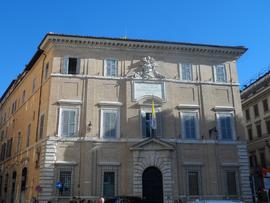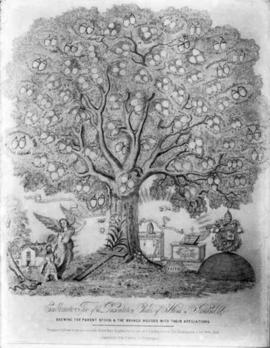- Vtest
- Corporate body
- 1600-2020
Showing 18 results
Authority recordThe Passionist Congregation, St. Patrick's Province
- CP
- Corporate body
- 1856-2019
Supreme Sacred Congregation of the Roman and Universal Inquisition
- HI
- Corporate body
- 1542-2023
https://www.newadvent.org/cathen/08026a.htm
The great apostasy of the sixteenth century, the filtration of heresy into Catholic lands, and the progress of heterodox teachings everywhere, prompted Paul III to establish the "Sacra Congregatio Romanae et universalis Inquisitionis seu sancti officii" by the Constitution "Licet ab initio" of 21 July, 1542. This inquisitional tribunal, composed of six cardinals, was to be at once the final court of appeal for trials concerning faith, and the court of first instance for cases reserved to the pope. The succeeding popes — especially Pius IV (by the Constitutions "Pastoralis Oficii" of 14 October, 1562, "Romanus Pontifex" of 7 April, 1563, "Cum nos per" of 1564, "Cum inter crimina" of 27 August, 1562) and Pius V (by a Decree of 1566, the Constitution "Inter multiplices" of 21 December, 1566, and "Cum felicis record." of 1566) — made further provision for the procedure and competency of this court. By his Constitution "Immensa aeterni" of 23 January, 1587, Sixtus V became the real organizer, or rather reorganizer of this congregation.
The Holy Office is first among the Roman congregations. Its personnel includes judges, officials, consultors, and qualificators. The real judges are cardinals nominated by the pope, whose original number of six was raised by Pius IV to eight and by Sixtus V to thirteen. Their actual number depends on the reigning pope (Benedict XIV, Constitution "Sollicita et Provida", 1733). This congregation differs from the others, inasmuch as it has no cardinal-prefect: the pope always presides in person when momentous decisions are to be announced (coram Sanctissimo). The solemn plenary session on Thursdays is always preceded by a session of the cardinals on Wednesdays, at the church of Santa Maria sopra Minerva, and a meeting of the consultors on Mondays at the palace of the Holy Office. The highest official is the commissarius sancti oficii, a Dominican of the Lombard province, to whom two coadjutors are given from the same order. He acts as the proper judge throughout the whole case until the plenary session exclusive, thus conducting it up to the verdict. The assessor sancti officii, always one of the secular clergy, presides at the plenary sessions. The promotor fiscalis is at once prosecutor and fiscal representative, while the advocatus reorum undertakes the defence of the accused. The duty of the consultors is to afford the cardinals expert advice. They may come from the secular clergy or the religious orders, but the General of the Dominicans, the magister sacri palatii, and a third member of the same order are always ex-officio consultors (consultores nati). The qualificators are appointed for life, but give their opinions only when called upon. The Holy Office has jurisdiction over all Christians and, according to Pius IV, even over cardinals. In practice, however, the latter are held exempt. For its authority, see the aforesaid Constitution of Sixtus V "Immensa aeterni" (see ROMAN CONGREGATIONS).
Sisters of St. Joseph of Chambery Auth Rec
- SJCH
- Corporate body
- 1939- present
The Sisters of St. Joseph Chambery arrived in Wales from India in 1939. In 1958 they founded a house in Dublin at the invitation of Archbishop John Charles McQuaid.
This is the current site of St. Josephs hospital, Raheny. They sold this hospital in 1997, but still maintain a convent on the same site.
In 1977 they also bought a house for the purposes of supporting a novitiate, but sold this in 2005.
- RM/SCR
- Corporate body
- 1588-1969
The Sacred Congregation of Rites was a congregation of the Roman Curia, erected on 22 January 1588 by Pope Sixtus V by Immensa Aeterni Dei; it had its functions reassigned by Pope Paul VI on 8 May 1969.
The Congregation was charged with the supervision of the liturgy, the dispensation of the decrees of Canonical coronations, other various sacraments, and the process of canonization of saints.
Sacred Congregation of Religious
- CongR
- Corporate body
- 1587-2023
https://www.newadvent.org/cathen/13136a.htm
Sixtus V first erected by a Brief of 17 May, 1586, and afterwards, by the Constitution "Immensa", confirmed, a congregation "super consultationibus regularium" distinct from the congregation "super consultationibus episcoporum et aliorum prælatorum" mentioned in the same Constitution. In 1601 these two congregations were already combined in the Congregation of Bishops and Regulars, to which, in course of time, were united three other congregations whose functions were closely related. These three were: the Congregation on the State of Religious (super statu regularium), created by Innocent X on 15 August, 1652, for the reformation of regulars in Italy, and suppressed by Innocent XII on 4 August, 1698; the Congregation on Regular Discipline (super disciplina regulari), instituted by Innocent XII on 18 July, 1695, for the reformation of regulars not only in Italy but throughout the whole world; the Congregation on the State of the Regular Orders (super statu regularium ordinum), created by Pius IX on 17 June, 1847. The last-named and the one on regular discipline were suppressed by Pius X, by the Motu Proprio of 26 May, 1906, which united these congregations with that of Bishops and Regulars. The new Constitution of Pius X abolishes the Congregation of Regulars and Bishops and transfers that part of its business which concerns bishops to the Congregation of the Council, and that part of it which concerns regulars to a congregation (oongregatio negotiis religiosorum sodalium præposita) created by the new Constitution, and which by common usage sanctioned by the legend on the official seal of the congregation, has received the name of Congregatio of Religious.
This body has the usual organization of the Roman Congregations. It is formed of several cardinals, who are chosen by the pope, and one of whom is the prefect of the congregation; these cardinals are assisted by a secretary and a sub-secretary, who are the major officials of the congregation, and by several minor officials. In regard to the latter it is to be noted that, as the amount of its business necessitates a division of the congregation into three parts (as in the case of the Congregation of the Sacraments), the highest dignitaries among the minor officials are the three assistants who are placed over the three sections. One of these sections has to deal with matters relating to religious orders; another, with the business of religious congregations or associations of men, of whatever nature those associations may be; the third, with business relating to congregations of women. This congregation also has a college of consultors.
The Constitution of Pius X clearly defines the competency of this congregation, which is to pass judgment upon all matters relating to religious persons of either sex, whether bound by solemn or by simple vows, or to those persons who, although they be not religious in the canonical sense of the word, live as religious — such as the oblates of certain communities of men or of women, who, without being bound by vows, live a common life under an approved rule. The third orders, consisting of seculars, are also under this congregation. It decides in litigations between members of religious orders, or between religious and bishops, and it is the competent tribunal in eases which have to be dealt with in the way of discipline (in via disciplinari) where a religious appears either as plaintiff or as defendant. Hence it is to be inferred, and indeed is expressly stated in the Constitution, that causes which have to be dealt with in the judicial way must be referred to the Rota, the rights of the Holy Office being always safeguarded. Finally, all common law dispensations to regulars pertain to this congregation, excepting dispensation from the Eucharistic fast, which, as said above, pertains to the Congregation of the Sacraments. The Congregatio of Religious is alone competent to approve new religions institutes and their constitutions, as well as to modify institutes already approved, and these being matters of grave importance, the full congregation deals with them.
Sacra Congregatio de Propaganda Fide
- VA/SCPF
- Corporate body
- 1622-2023
The Sacred Congregation de Propaganda Fide, whose official title is "sacra congregatio christiano nomini propagando" is the department of the pontifical administration charged with the spread of Catholicism and with the regulation of ecclesiastical affairs in non-Catholic countries. The intrinsic importance of its duties and the extraordinary extent of its authority and of the territory under its jurisdiction have caused the cardinal prefect of Propaganda to be known as the "red pope".
- IE PVBM
- Corporate body
- 1600-2023
- PB
- Corporate body
- 1795-2021
The Presentation Brothers are an international, Catholic congregation of religious brothers, founded in 1802 by Blessed Edmund Rice in Waterford, Ireland. The expressed mission of the Presentation Brothers is to "form Christ in the Young" and traditionally they have worked to achieve this through education.
Edmund Rice was born in the townland of Westcourt near the village of Callan in County Kilkenny on 1 June 1762. His parents, Robert Rice and Margaret Tierney Murphy, were prosperous farmers. At the age of 17, Rice was apprenticed to his uncle, Michael Rice, in Waterford city. Several years later, Edmund’s uncle signed the business over to him and Edmund began to invest his growing fortune in land and property. At the age of 25, Edmund married Mary Elliott but, sadly, Mary died in January 1789 following a horse-riding accident. Edmund and Mary had a daughter who was also called Mary.
After his wife’s death, Rice became more religious and he developed a devotion to St. Teresa of Avila. He also became involved in charitable works and regularly visited the poor of Waterford providing financial assistance to those in need. In 1798, Edmund helped the Presentation Sisters open a convent and school for girls in Waterford. Rice decided to try something similar for young boys, and in 1800 he began to teach youngsters at his business premises in Barronstrand Street with the assistance of some volunteers. The following year, Rice converted some stables on New Street into a makeshift school. His friends and colleagues described it as an act of "mad folly". Two men, Patrick Grosvenor and Patrick Finn, arrived to help. The three men lived above the school where they prayed together and shared their possessions. This school would go on to be known as Mount Sion Primary School which exists to this day.
Between 1802, when he opened his first school and 1808, Rice gathered around him a group of companions to help him in his work. These first Brothers took their vows on 15th August 1808 in the chapel of the Presentation Convent, Waterford, and together they became known as the Society of the Presentation. They lived their religious life based on the Rule of the Presentation Sisters (founded by the Venerable Nano Nagle in 1775), adapted for men. The Presentation Rule defined the new institute as a diocesan institute. This meant that, initially in Waterford, and later on in other dioceses where the Brothers worked, the local Bishop was their Superior. Unlike institutes of pontifical rite, the new religious institute had no Superior General of its own.
As the work of Edmund Rice expanded to Dublin, Cork and other Irish cities and towns, a need for central planning and direction emerged in the developing educational mission of the Brothers. From 1817 onwards, Edmund Rice began to consider adopting a constitution along the lines of that used by the Brothers of the Christian Schools in France. The De La Salle Brothers were an institute of pontifical rite, and had their own Superior General and elected administration. They were, to a great extent, independent of local bishops and this gave them great freedom in the development and expansion of their work. Rice felt that the Presentation Rule had served the group well in its early years, but Rome would only grant his group pontifical status if they adopted a pontifical rule already in existence. He decided to propose to his Brothers that the group should adopt a new De La Salle style rule. Controversy and debate ensued over a number of years and ultimately led to a division within the group. The vast majority of the Brothers ultimately accepted the adoption of a rule along the lines of that used by the Brothers of the Christian Schools in France. A minority of two continued to live the Presentation Rule and remained under the jurisdiction of their local bishops. The majority, known as the Christian Brothers since 1822, elected Edmund Rice as their first Superior General. The group experienced considerable expansion and development during the following decades.
Of the two Brothers who chose to remain with the Presentation Rule, Brother John Ignatius Mulcahy taught at a school in Cappoquin, County Waterford until his death in 1845. He was not joined by any followers. The second Brother, Michael Augustine Riordan of Cork, was joined by a number of followers and continued to follow the Presentation rule.
Brother Michael Augustine Riordan had entered the North Monastery in Cork in 1814 (there had been a community of Brothers in Cork since 1811; Brother Jerome O'Connor and Brother John Baptist Leonard founded the Peacock Lane Monastery, also known as the North Presentation Monastery, and were given charge of the Cork Charitable Society’s North School off Chapel Lane by the Bishop of Cork, Dr Francis Moylan). There had been considerable division in the North Monastery concerning the acceptance of the new rule over a number of years. An architect by profession, Riordan had helped in the building of many Cork churches before his entrance to the Brothers. His personal sense of loyalty to the then Bishop of Cork, John Murphy, greatly influenced his decision to remain with the Presentation Rule. In 1827, with the support of Bishop Murphy, he left the North Monastery and was given a house in Douglas Street, on the south side of the city. This became known as the South Monastery and Brother Riordan was joined there by some companions who lived as Presentation Brothers under the jurisdiction of the Bishop of Cork.
The Brothers began to conduct two schools in the city, one in the South Monastery itself, another a Lancasterian School on Great George's Street, today known as Washington Street. Thus, Brother Riordan played a pivotal role in the survival of the Institute of Presentation Brothers who would continue to live the original rule chosen by Edmund Rice and his early companions.
The Presentation Brothers continued their work in the Cork schools and expanded to Kerry in 1838. A foundation was made in Deptford, England in 1876 and in Birr, Co. Offaly, in 1879. By the 1870s however, a new younger group of Brothers began to address the issue of diocesan versus central control. As various types of schools were founded in diverse places, it became obvious that the Presentation Congregation should develop from its present diocesan status to being an institute of pontifical rite. In 1874, the Bishops of Cork and Kerry, on behalf of the Brothers, requested Rome to grant pontifical approval to the Presentation Institute. A Decree was received from Rome in the same year granting temporary approvaI. In 1885, the Presentation Brothers submitted a petition to Rome requesting its approval for a central government for the Presentation Institute under its own Superior General. By 1889, Rome granted temporary approval and final approbation came ten years later in 1899.
Throughout these developments, the Brothers retained the original Presentation Rule. Changes were inserted however to allow for a central government under a superior general and council. The first formal general chapter of the Brothers of the Presentation Institute was held in the South Monastery Cork in July 1889. Brother Patrick Shine was elected superior general and with him four assistants to help in the government of the Congregation.
The number of communities and schools established and managed by the Presentation Brothers greatly increased in the subsequent decades, both in Ireland (including Cork, Cobh, Kinsale, Bray, Dungannon, Enniskillen, Carrick-on-Shannon, Boyle, Letterkenny) and overseas (including Canada, USA, Ghana, Nigeria, Barbados, Grenada, St Lucia, Trinidad and Tobago, Peru, and Slovakia).
The Presentation Brothers have a presence in a number of these locations to the present day, and continue to work in the area of education as well as a wider range of ministries including with the homeless, elderly, disadvantaged youth and the Roma people.
Much of this history of the Presentation Brothers was sourced from 'The Contribution of the Presentation Brothers to Irish Education 1960-1998: A Study of a Roman Catholic Religious Teaching Institute in a Time of Change and Transition', a PhD thesis written and submitted to the University of Hull by Br Michael Martin Kenneally.
Little Sisters of the Poor Auth Rec
- IE/LSP
- Corporate body
- 1880-2020





